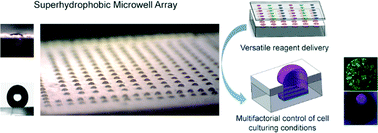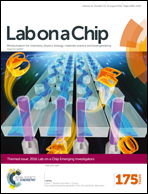High-throughput superhydrophobic microwell arrays for investigating multifactorial stem cell niches†
Abstract
Understanding the complex regulatory network that determines stem cell fates requires a high-throughput platform that can generate a large number of precisely controlled microenvironments representing multiple factors for stem cell culture and analysis. Here, we developed a superhydrophobic microwell array chip on which the culture conditions in each microwell can be spontaneously isolated by a grafted layer of superhydrophobic polymers. Simple steps for medium exchange were developed to facilitate the on-chip culture of both adherent and non-adherent cells for up to six days without compromising cell viability and functionality. The culture conditions in each microwell were facilely manipulated using a robotic spotter. Stem cell niches combining soluble factors, extracellular matrices and microtopographic cues were generated on a single 512-well SMARchip and their combinatorial effects on the fate of mouse Oct4-EGFP iPSCs were systematically probed. We observed significant differences in iPSC pluripotency and proliferation between adherent flat and suspended spherical cultures on our platform, which might provide insights into improvement of stem cell technologies.

- This article is part of the themed collection: 2016 Lab on a Chip Emerging Investigators

 Please wait while we load your content...
Please wait while we load your content...